| Term |
Source |
Meaning |
Illustration |
| Mahlstick |
Foo, Suan-Seh. Vol III, P 280 |
 The Mahlstick (shown here in bend) is a padded stick employed by painters. It is used to support the hand holding the paintbrush, to prevent it from touching the painted surface. It is used here to allude to the grantee’s avocation as a painter. The Mahlstick (shown here in bend) is a padded stick employed by painters. It is used to support the hand holding the paintbrush, to prevent it from touching the painted surface. It is used here to allude to the grantee’s avocation as a painter. |
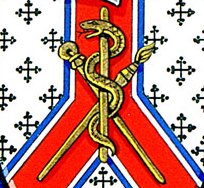 |
| Mahonne |
Town of Mahone Bay, NS (Crest) Vol II, P20 |
The Mahonne is an ancient watercraft, propelled by sail or oars, which was used primarily on the Black Sea. It is used here as a rebus on the name of the town. |
 |
| Maple Leaf |
Riley, J.A.L., Vol. V P186 |
 The Maple Leaf is used universally to represent Canada. The Maple Leaf is used universally to represent Canada. |
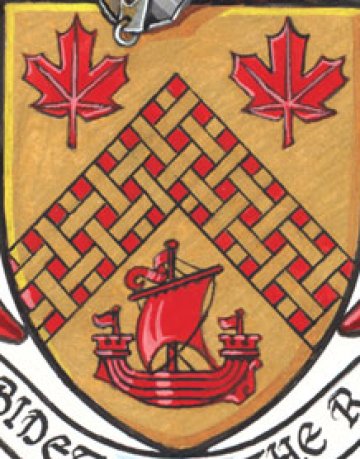 |
| Maple Leaf en Soleil |
Cadet Camp, Vernon. (Badge) Vol II, P 406 |
 The Maple Leaf en Soliel (the points of the leaf irradiated with sun-like rays) is an ingenious heraldic device, aimed at combining Canada's traditional symbol with the majesty and glory of the sun. It also suggests the motto, "Without Equal". The three mountain peaks from which it arises allude to the majestic Rocky Mountains. The Maple Leaf en Soliel (the points of the leaf irradiated with sun-like rays) is an ingenious heraldic device, aimed at combining Canada's traditional symbol with the majesty and glory of the sun. It also suggests the motto, "Without Equal". The three mountain peaks from which it arises allude to the majestic Rocky Mountains. |
 |
| Maple Leaf of Flames |
Gulf of St. Lawrence (Flag) Vol IV, P 16 |
 This shows Canada's emblem, the maple leaf, as composed of flames. The gridiron-and-flames motif is a traditional reference to St Lawrence, in reference to his martyrdom by burning. This shows Canada's emblem, the maple leaf, as composed of flames. The gridiron-and-flames motif is a traditional reference to St Lawrence, in reference to his martyrdom by burning. |
 |
| Maple Seed |
Ferris, J.D., (Flag) Vol VI, P 449 |
 The Maple Seed, as well as the leaf, can be used as a symbol of Canada. In this case, its shape - and the gyrating way it falls - also suggest the blades of a helicopter, as flown by the grantee. The Maple Seed, as well as the leaf, can be used as a symbol of Canada. In this case, its shape - and the gyrating way it falls - also suggest the blades of a helicopter, as flown by the grantee. |
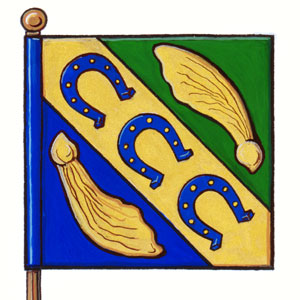 |
| Maple Seeds in Saltire |
Association of Universities and Colleges |
An interesting use of the maple seed. |
 |
| Marguerite Daisy |
St. Margaret's School, Victoria, BC (Badge) Vol V, P 232 |
 The Marguerite Daisy in the base of the arms is a visual reference to Margaret, Queen of Scotland in the 11th century, later canonized as Saint Margaret. The Marguerite Daisy in the base of the arms is a visual reference to Margaret, Queen of Scotland in the 11th century, later canonized as Saint Margaret. |
 |
| Martello Tower |
772 Electronic Warfare Squadron, RCAF Kingston, ON. (Badge) Vol V, P 405 |
 The Martello Tower is a 19th-century defensive fortification found in many parts of Canada, many of them in Kingston. The Martello Tower is a 19th-century defensive fortification found in many parts of Canada, many of them in Kingston. |
 |
| Martlet, Maple Leaf |
Pepino |
A martlet depicted so that its sinister aspect resembles a maple leaf. See also Canadian Martlet, which is identical. |
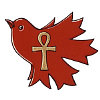 |
| Masks of Comedy and Tragedy |
Roux |
These have been used in British heraldry, one can be sure, but they do not appear in any standard heraldic dictionaries. Like the chapé embowed, they are of course associated with the stage. |
 |
| Masonic Square |
Montgomery |
 A well-known emblem of the Masonic Order, the square is here shown on the shoulder of a fox. A well-known emblem of the Masonic Order, the square is here shown on the shoulder of a fox. |
 |
| Mayflower - Natural |
Official Flowers of Canada |
 The Mayflower, as shown here in its natural state, is the Provincial flower of Nova Scotia. The Mayflower, as shown here in its natural state, is the Provincial flower of Nova Scotia. |
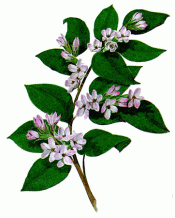 |
| Mayflower - Heraldic |
Cape Breton Highlanders (Badge) Vol VI, P 357 |
 The Mayflower (three shown here near the centre of the badge) is the Provincial flower of Nova Scotia. The Mayflower (three shown here near the centre of the badge) is the Provincial flower of Nova Scotia. |
 |
| Medicine Man's Headdress |
City of Medicine Hat, Alberta. Vol III, P 230 |
The Headdress in the crest refers to the Assiniboine Nation who lived in the Great Plains. It is a direct reference to the name of the city of Medicine Hat. |
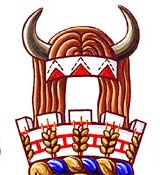 |
| Medicine Wheel |
|
 A symbol of the plains Indian tribes, the medicine wheel was constructed of stones – a cairn in the centre, an outer ring of stones with “spokes” of stone radiating out from the centre. It was used for various spiritual and ritual purposes, especially for healing almost any illness. Being a wheel, it is round, depicting the circle of life, the shape of the sun and the moon, etc. A symbol of the plains Indian tribes, the medicine wheel was constructed of stones – a cairn in the centre, an outer ring of stones with “spokes” of stone radiating out from the centre. It was used for various spiritual and ritual purposes, especially for healing almost any illness. Being a wheel, it is round, depicting the circle of life, the shape of the sun and the moon, etc. |
 |
| Menorah |
B'Nai Brith |
The seven-branched candlestick of the Jewish faith. |
 |
| Mercury |
Greater Vancouver Transportation Authority Police Service. Vol IV, P 420 |
In Roman mythology, Mercury was the god of commerce, communications and travel. He had winged heels and was known for his swift flight. He is shown in these arms to allude to swiftness of action and response. |
 |
| Mercury, Figure of |
712 (Montreal) Communications Sqn. (Badge) Vol II, P 413 |
 Mercury, known as the Messenger of the Gods, was the Roman God of travel and commerce. He is typically shown as an athlete, with winged feet, wearing a winged cap and carrying a caduceus (a herald's staff with two entwined snakes), a gift from the god Apollo. Mercury in this instance symbolizes the idea of rapid communication. Mercury, known as the Messenger of the Gods, was the Roman God of travel and commerce. He is typically shown as an athlete, with winged feet, wearing a winged cap and carrying a caduceus (a herald's staff with two entwined snakes), a gift from the god Apollo. Mercury in this instance symbolizes the idea of rapid communication. |
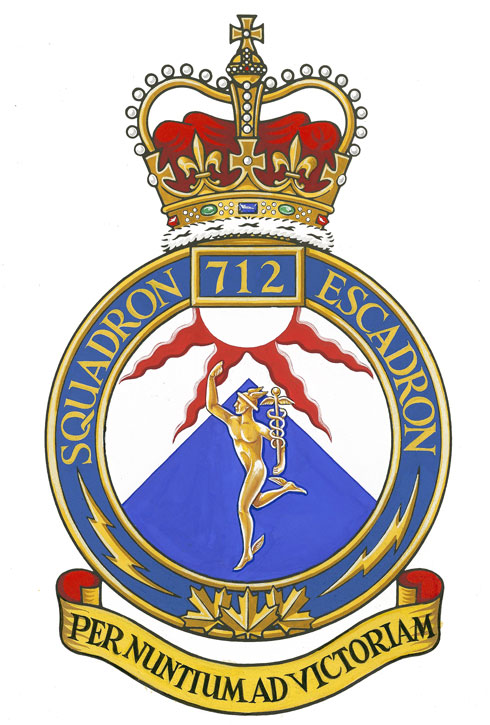 |
| Merged |
Abbottsford |
The blazon reads, "Vert a cross and saltire merged Or voided Azure and overall in centre point a bezant ...". An alternative blazon might read, "... a cross Or voided Azure surmounted with a like saltire and over all ... etc". |
 |
| Microphone |
Lewis, F.H. Vol VI, P 236 |
 The Microphone refers to the grantee’s son’s work in radio broadcasting. It may also refer to the broadcasting of religious or other concepts. The Microphone refers to the grantee’s son’s work in radio broadcasting. It may also refer to the broadcasting of religious or other concepts. |
 |
| Métis Sash |
Dawson Creek. Vol V, P 258 |
 The elks supporting these arms are wearing sashes referring traditionally to the Metis people of the Canadian West and Northwest. The elks supporting these arms are wearing sashes referring traditionally to the Metis people of the Canadian West and Northwest. |
 |
| Milk Pail |
Town of Stewiacke, NS. Vol. V P184 |
 The two milk pails in the shield indicate the importance of the dairy industry to the area. The two milk pails in the shield indicate the importance of the dairy industry to the area. |
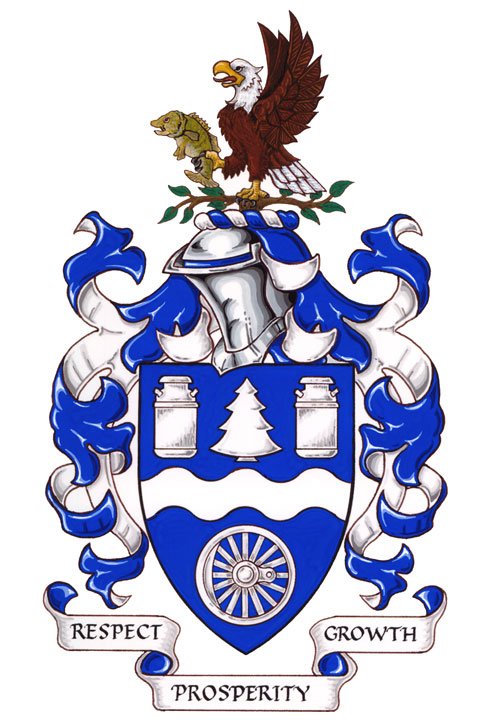 |
| Mi'kmaq Star |
Annapolis Municipality |
 The star consists of a simple cross, each arm of a different tincture and terminating in a V-shaped notch. The star consists of a simple cross, each arm of a different tincture and terminating in a V-shaped notch. |
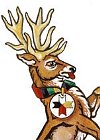 |
| Mi'kMaq Star |
University College, Cape Breton (Badge) Vol III, P 335 |
The eight-pointed Mi’kmaq Star is a sacred symbol of the Mi’kmaq people. It is used here as a reminder of the central role that the native community plays on Cape Breton Island. |
 |
| Minaret |
Koundakjian, Vicken. Vol V, P 475 |
 The bridge alludes to the grantee’s work as a diplomat, seeking to bridge differences between the East (symbolized by the Minaret) and the West (symbolized by the castle tower). The bridge alludes to the grantee’s work as a diplomat, seeking to bridge differences between the East (symbolized by the Minaret) and the West (symbolized by the castle tower). |
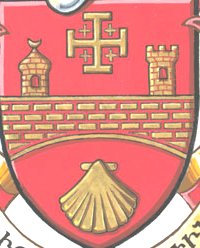 |
| Mishipeshuweg |
Gemini Power Corporation. Vol VI, P 342 |
 The Mishipeshuweg (two seen here as supporters) is a beast from Anishinaabe and other First Nations mythology. It is a water-dwelling Lynx-like creature, complementary to the Thunderbird. In this case, it indicates the potential power of bodies of water. The Mishipeshuweg (two seen here as supporters) is a beast from Anishinaabe and other First Nations mythology. It is a water-dwelling Lynx-like creature, complementary to the Thunderbird. In this case, it indicates the potential power of bodies of water. |
 |
| Mission Cross |
District of Mission, BC. Vol II, P 148 |
 The Mission Cross - a Latin cross tipped with firs - symbolizes the idea of the early missionaries preaching the Christian faith in the wooded wilds of North America. In these arms, it refers directly to the name of the District. (It is shown in this illustration as Vert, charged with an Oblate cross Or). The Mission Cross - a Latin cross tipped with firs - symbolizes the idea of the early missionaries preaching the Christian faith in the wooded wilds of North America. In these arms, it refers directly to the name of the District. (It is shown in this illustration as Vert, charged with an Oblate cross Or). |
 |
| Moose |
Rotary international 7070 |
 One of the two major ungulates of temperate North America – the other being the elk. One of the two major ungulates of temperate North America – the other being the elk. |
 |
| Mortarboard |
University Club of Montreal. Vol VI, P 116 |
 The Mortar Board is a form of university headgear, used here to emphasise the important role that university professors have played in the club. The Mortar Board is a form of university headgear, used here to emphasise the important role that university professors have played in the club. |
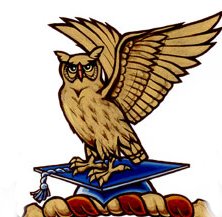 |
| Mortarboard |
Casselman, E.J. Vol IV, P 27 |
 The Mortarboard is a square academic cap, and has long been a symbol for academia and for persons associated with university education in general. The Mortarboard is a square academic cap, and has long been a symbol for academia and for persons associated with university education in general. |
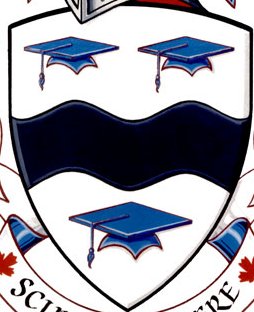 |
| Mountain Avens - Natural |
Provincial Flowers of Canada |
 The Mountain Avens (shown here in its natural form) is the territorial flower of the Northwest territories. The Mountain Avens (shown here in its natural form) is the territorial flower of the Northwest territories. |
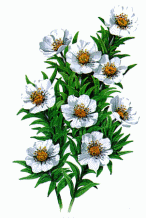 |
| Mountain Bluebird |
Town of Lacombe, Alta. (Badge) Vol IV, P 284. |
 The Mountain Bluebird is found in or near the mountainous areas of North America. The Mountain Bluebird is found in or near the mountainous areas of North America. |
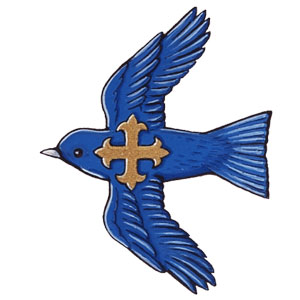 |
| Mountain Goat |
Phillips, D.G. Vol VI, P 141 |
 The Mountain Goat (actually an antelope), shown here as the dexter supporter, is a typical animal of the western mountains of North America. The Mountain Goat (actually an antelope), shown here as the dexter supporter, is a typical animal of the western mountains of North America. |
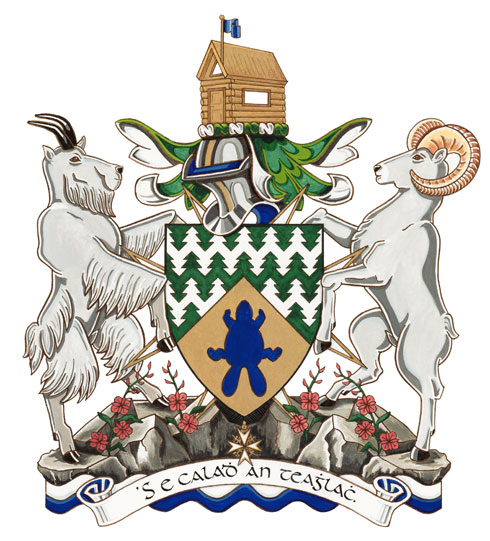 |
| Mountain Lady's Slipper |
Town of St. Walburg, Sask. Vol V, P 192 |
 The Lady's Slipper - a rare flower - appears in the shield, representing environmental planning. The Lady's Slipper - a rare flower - appears in the shield, representing environmental planning. |
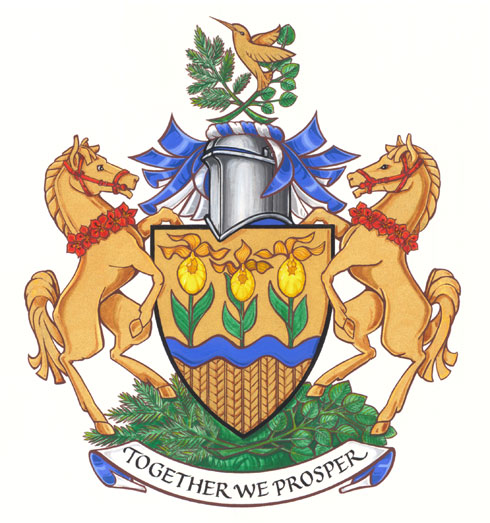 |
| Mule Deer |
Penhold, Alberta. Vol VI, P 386 |
 The Mule Deer supporters are animals frequently found in the Penhold area. The Mule Deer supporters are animals frequently found in the Penhold area. |
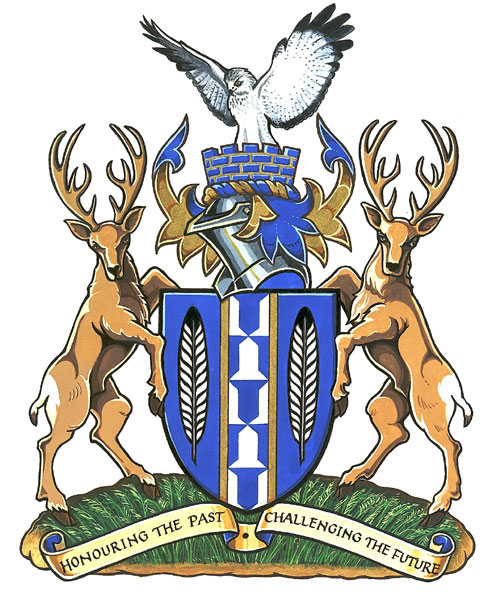 |
| Mullein Plant |
Robichaud, S., Vol VI, P 270 |
 The Mullein (shown in the flanks of the shield) is a medicinal plant known for its benefits to the respiratory system. It was indexed by Louis Hébert, the first apothecary in Acadia. The Mullein (shown in the flanks of the shield) is a medicinal plant known for its benefits to the respiratory system. It was indexed by Louis Hébert, the first apothecary in Acadia. |
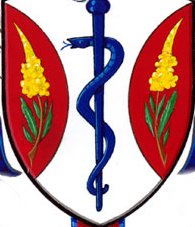 |
| Musical Eighth Note |
Dumbrill, S.J. Vol III, P 134 |
 The Eighth Note or quaver is a common symbol in musical notation. It is used here to allude to the grantee’s passion for music. The Eighth Note or quaver is a common symbol in musical notation. It is used here to allude to the grantee’s passion for music. |
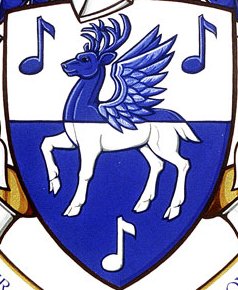 |
| Musk Ox |
|
A beast of the far North. |
 |
| Musk Ox (entire animal) |
Irniq, P., Vol IV, P 133 |
 The Musk Ox is a beast of the far north. It represents here an animal of Nunavut. The Musk Ox is a beast of the far north. It represents here an animal of Nunavut. |
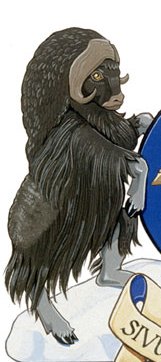 |
| Mute Swan |
Brighton, ON. Vol V, P 200 |
 The mute swans, shown as supporters, are local water-birds. The mute swans, shown as supporters, are local water-birds. |
 |



